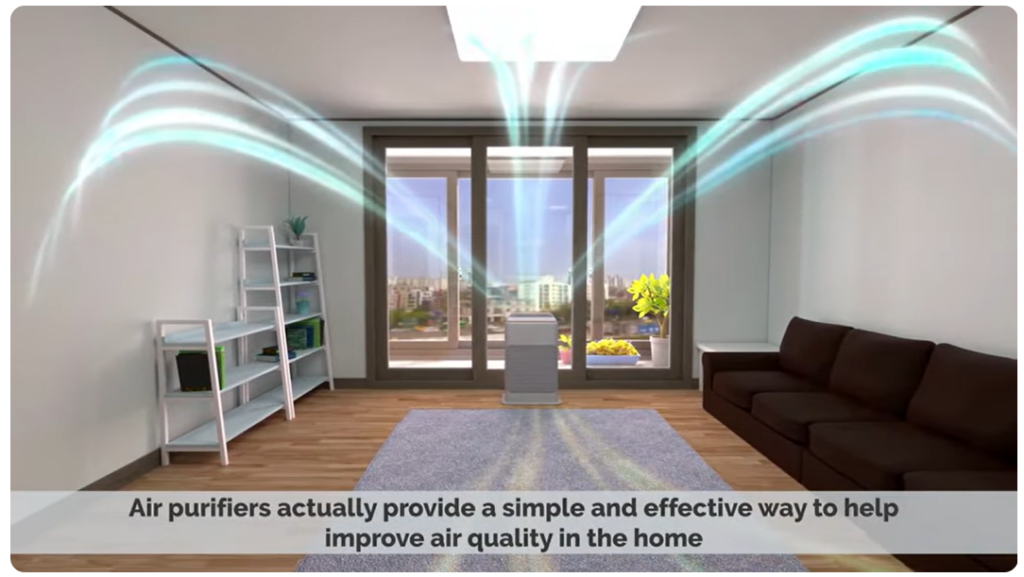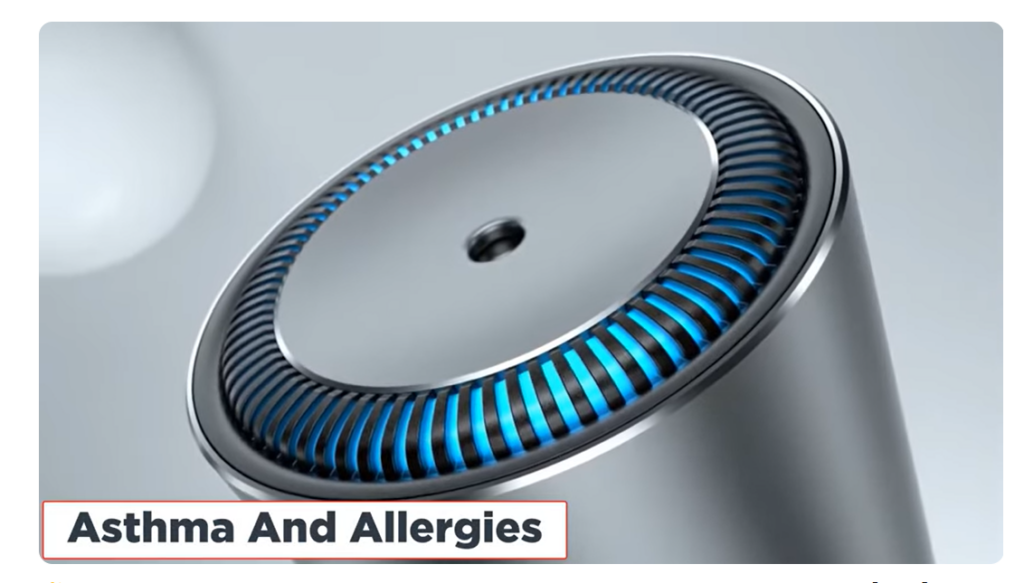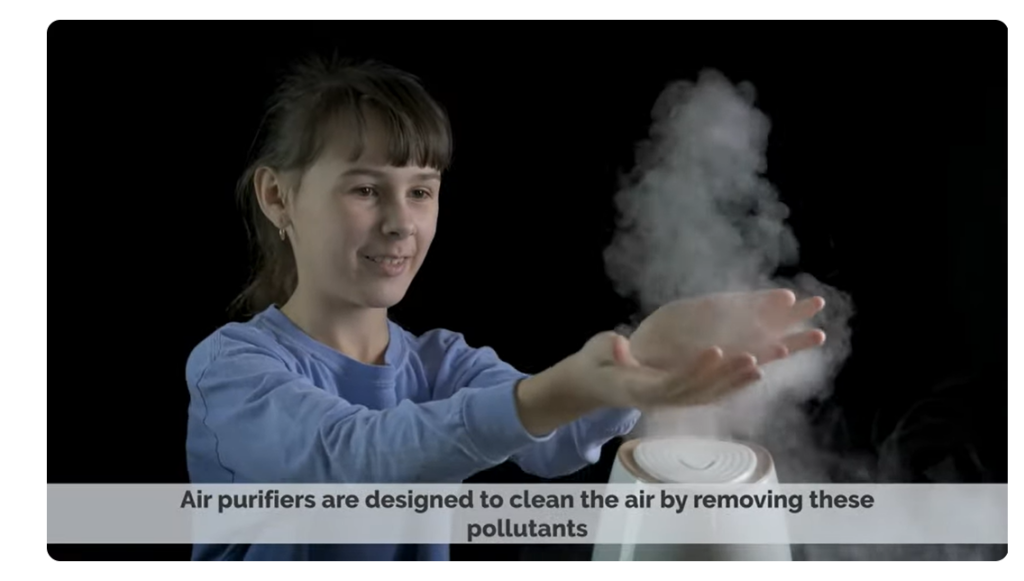Yes, air purifiers can remove smoke. This guide dives deep into how air purifiers tackle smoke, focusing on choosing the best air purifier for smoke removal and ensuring effective air purification in your home or office.

Fathoming Smoke and Its Dangers
Smoke isn’t just an annoyance; it’s a complex mixture of gases and tiny particles that can seriously harm your health. These particles, especially PM2.5 (particulate matter with a diameter of 2.5 micrometers or less), can travel deep into your lungs and even enter your bloodstream.
Smoke Composition: A Breakdown
- Particulate Matter (PM): Tiny solid and liquid particles suspended in the air. PM2.5 is the most dangerous due to its small size.
- Gases: Carbon monoxide, nitrogen oxides, sulfur dioxide, volatile organic compounds (VOCs), and more.
- Ash: Solid residue from burning materials.
Health Risks Associated with Smoke Exposure
- Respiratory Problems: Coughing, wheezing, shortness of breath, asthma attacks.
- Cardiovascular Issues: Increased risk of heart attacks and strokes.
- Eye and Throat Irritation: Burning, stinging, and dryness.
- Long-Term Effects: Chronic respiratory diseases, cancer.
How Air Purifiers Combat Smoke
Air purifiers work by drawing air in, filtering it, and then releasing the cleaned air back into the room. The effectiveness of an air purifier for smoke depends on the types of filters it uses.
The Power of HEPA Filters
HEPA (High-Efficiency Particulate Air) filters are the cornerstone of air purification for smoke. They are designed to capture at least 99.97% of particles that are 0.3 microns in diameter – which includes smoke particles.
- Mechanism: HEPA filters use a combination of interception, impaction, and diffusion to trap particles.
- Effectiveness: Highly effective at removing PM2.5 and other particulate matter from smoke.
- Limitations: HEPA filters do not remove gases or odors.
Activated Carbon Filters: Neutralizing Gases and Odors
Activated carbon filters are crucial for removing the gases and odors present in smoke.
- Mechanism: Activated carbon is treated to create a large surface area, allowing it to adsorb gases and VOCs.
- Effectiveness: Effective at removing smoke odors and harmful gases.
- Limitations: Activated carbon filters need to be replaced regularly as they become saturated.
Other Filter Types: A Supporting Role
- Pre-filters: Capture larger particles like dust and pet dander, extending the life of the HEPA and activated carbon filters.
- UV-C Light: Some air purifiers include UV-C light to kill bacteria and viruses, but its effectiveness against smoke is limited.
- Ionizers/Ozone Generators: While some air purifiers use ionization, it’s important to avoid ozone generators. Ozone is a lung irritant and can be harmful.
Selecting the Best Air Purifier for Smoke
Choosing the right air purifier for smoke involves considering several factors.

CADR (Clean Air Delivery Rate): The Key Metric
CADR measures how quickly an air purifier can clean a room of a specific size. It is rated for smoke, dust, and pollen.
- Importance: A higher CADR indicates better performance.
- Matching CADR to Room Size: Choose an air purifier with a CADR rating appropriate for the size of the room you want to purify. For example, if a room is 500 square feet, you’ll need a higher CADR than for a 200 square foot room. Look for models with high CADR ratings for smoke specifically.
Filter Quality and Replacement
- HEPA Filter: Ensure the air purifier has a genuine HEPA filter.
- Activated Carbon Filter: Look for a substantial amount of activated carbon for effective gas and odor removal.
- Filter Replacement: Consider the cost and frequency of filter replacement. Air purifier filter for smoke needs to be changed frequently when dealing with heavy smoke pollution.
Features to Consider
- Air Quality Sensors: Detect smoke levels and automatically adjust fan speed.
- Multiple Fan Speeds: Allow you to adjust the purification level.
- Quiet Operation: Important for bedrooms and living areas.
- Smart Features: Some air purifiers can be controlled via smartphone apps.
Air Purifier for Wildfire Smoke Considerations
Wildfire smoke presents a unique challenge due to its intensity and widespread nature. When selecting an air purifier for wildfire smoke, prioritize models with:
- High CADR ratings: To quickly clean the air in larger spaces.
- Large activated carbon filters: To handle the high concentration of gases and odors.
- Durable construction: Capable of withstanding prolonged use.
Air Purifier for Cigarette Smoke
Cigarette smoke is particularly pungent and contains numerous harmful chemicals. Air purifier for cigarette smoke require:
- Enhanced Activated Carbon Filtration: Look for air purifiers with specialized activated carbon filters designed to target cigarette smoke odors and gases.
- Pre-filters: To capture larger particles and extend the life of the other filters.
- Regular Filter Replacement: Cigarette smoke can quickly saturate filters, so be prepared to replace them more frequently.
Optimizing Air Purifier Smoke Particles Removal
To maximize the effectiveness of your air purifier:
- Placement: Place the air purifier in the room where you spend the most time.
- Keep Windows and Doors Closed: Prevent outdoor smoke from entering your home.
- Run the Air Purifier Continuously: Especially during periods of heavy smoke.
- Regularly Clean or Replace Filters: Follow the manufacturer’s recommendations for filter maintenance.
- Supplemental Measures: Consider using additional measures, such as sealing gaps around windows and doors, to further reduce smoke infiltration.
Examining Air Purifier Smoke Effectiveness
While air purifiers are effective at removing smoke, it’s important to have realistic expectations.
Factors Affecting Effectiveness
- Smoke Concentration: Very high smoke levels may overwhelm the air purifier.
- Room Size: An undersized air purifier will struggle to clean a large room.
- Filter Maintenance: Clogged filters reduce the air purifier’s effectiveness.
Scientific Evidence
Numerous studies have shown that air purifiers with HEPA and activated carbon filters can significantly reduce indoor air pollution from smoke.
- Research Findings: Studies have demonstrated a reduction in PM2.5 levels and improved air quality in homes using air purifiers.
- Expert Recommendations: Organizations like the EPA and the American Lung Association recommend using air purifiers to reduce smoke exposure.
Maintaining Your Air Purifier for Peak Performance
Proper maintenance is crucial to ensure your air purifier continues to effectively remove smoke.

Filter Replacement Schedule
- Pre-filters: Clean or replace every 1-3 months.
- HEPA Filters: Replace every 6-12 months.
- Activated Carbon Filters: Replace every 3-6 months, or more frequently if exposed to heavy smoke.
Cleaning Your Air Purifier
- Exterior: Wipe down the exterior of the air purifier with a damp cloth regularly.
- Air Vents: Vacuum the air vents to remove dust and debris.
- Sensors: Clean the air quality sensors (if applicable) according to the manufacturer’s instructions.
Navigating Air Purifier Myths and Misconceptions
There are several misconceptions about air purifiers that need to be addressed.
- Myth: All air purifiers are the same. Fact: Air purifiers vary widely in terms of filter quality, CADR, and features.
- Myth: Air purifiers eliminate all indoor air pollutants. Fact: Air purifiers primarily target particulate matter and gases.
- Myth: Air purifiers are a substitute for proper ventilation. Fact: Air purifiers should be used in conjunction with proper ventilation.
- Myth: An air purifier will completely eliminate smoke odor instantly. Fact: While they reduce odors, it takes time and depends on the severity.
Smoke Removal Air Purifier: A Buyer’s Guide for 2024
This section provides practical guidance on purchasing an air purifier for smoke in 2024.
Setting a Budget
- Entry-Level: \$100-\$200. Suitable for small rooms and light smoke.
- Mid-Range: \$200-\$400. Offers better performance and features for medium-sized rooms.
- High-End: \$400+. Provides the best performance, advanced features, and coverage for large rooms.
Where to Buy
- Online Retailers: Amazon, Home Depot, Lowe’s.
- Specialty Stores: Allergy buyers club, Sylvane
- Manufacturer Websites: Directly from brands like Blueair, Dyson, and Coway.
Reading Reviews and Comparisons
- User Reviews: Pay attention to reviews that mention smoke removal performance.
- Expert Reviews: Consult reputable sources like Consumer Reports and Wirecutter.
- Comparison Charts: Use comparison charts to compare CADR ratings, filter types, and features.
Alternatives to Air Purifiers
While air purifiers are effective, consider these complementary strategies:
- Improve Ventilation: Open windows (when air quality is good) to circulate fresh air.
- Seal Windows and Doors: Prevent smoke from entering your home.
- Use a Furnace Filter: Upgrade your furnace filter to a MERV 13 or higher to capture more particles.
- Avoid Smoke-Generating Activities: Refrain from smoking indoors, burning candles, or using fireplaces during periods of heavy smoke.
Decoding Air Purifier Technology
Let’s further explore the technology that makes air purifiers effective.
HEPA Filter Technology
- Material Composition: HEPA filters are typically made of fiberglass, cellulose, or synthetic fibers.
- Filter Density: The dense network of fibers traps particles of various sizes.
- Filter Certification: Look for HEPA filters that are certified to meet industry standards.
Activated Carbon Filter Technology
- Activation Process: Activated carbon is treated with oxygen at high temperatures to create a porous structure.
- Adsorption Capacity: The larger the surface area, the more gases and odors the filter can adsorb.
- Carbon Types: Different types of activated carbon, such as coconut shell carbon, are used for specific applications.
Emerging Technologies
- PECO (Photo Electrochemical Oxidation): Destroys pollutants at a molecular level.
- Electrostatic Precipitators: Use an electrical charge to attract and trap particles.
- Hybrid Filters: Combine multiple filter types for comprehensive air purification.
Does Air Purifier Help With Smoke? Real-Life Applications
Consider real-life scenarios where air purifiers can make a significant difference.
- Homes Near Wildfire Zones: Air purifiers can provide a safe haven from wildfire smoke.
- Apartments with Poor Ventilation: Air purifiers can improve air quality in poorly ventilated spaces.
- Offices with High Occupancy: Air purifiers can reduce the spread of airborne particles in crowded offices.
- Homes with Smokers: Air purifiers can help mitigate the effects of secondhand smoke.
Frequently Asked Questions (FAQ)
- Q: How long does it take for an air purifier to clean a smoky room?
- A: It depends on the size of the room and the CADR of the air purifier. Generally, it can take 30 minutes to an hour to significantly reduce smoke levels.
- Q: Can I use an air purifier to remove mold spores?
- A: Yes, air purifiers with HEPA filters can remove mold spores from the air. However, they will not eliminate mold growth.
- Q: Are air purifiers noisy?
- A: Some air purifiers can be noisy, especially at high fan speeds. Look for models with a low noise level rating.
- Q: Can I use an air purifier in a small space like a car?
- A: Yes, there are portable air purifiers designed for use in cars.
- Q: How do I know when to replace my air purifier filters?
- A: Follow the manufacturer’s recommendations for filter replacement. You may also notice a decrease in air purifier performance or a lingering smoke odor.
In conclusion, an air purifier for smoke is a valuable investment for improving indoor air quality. By selecting the right air purifier and maintaining it properly, you can create a healthier and more comfortable living environment.
My name is Carlos Gadd, and I am the creator of AirPurityGuide.com.. With a passion for footwear, I share my experiences, insights, and expertise about shoes. Through my blog, I aim to guide readers in making informed decisions, finding the perfect pair, and enhancing their footwear knowledge. Join me on this journey to explore everything about shoes!